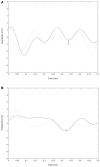Phonological Ambiguity Detection Outside of Consciousness and Its Defensive Avoidance
- PMID: 31024274
- PMCID: PMC6460346
- DOI: 10.3389/fnhum.2019.00077
Phonological Ambiguity Detection Outside of Consciousness and Its Defensive Avoidance
Abstract
Freud proposes that in unconscious processing, logical connections are also (heavily) based upon phonological similarities. Repressed concerns, for example, would also be expressed by way of phonologic ambiguity. In order to investigate a possible unconscious influence of phonological similarity, 31 participants were submitted to a tachistoscopic subliminal priming experiment, with prime and target presented at 1 ms. In the experimental condition, the prime and one of the 2 targets were phonological reversed forms of each other, though graphemically dissimilar (e.g., "nice" and "sign"); in the control condition the targets were pseudo-randomly attributed to primes to which they don't belong. The experimental task was to "blindly" pick the choice most similar to the prime. ERPs were measured with a focus on the N320, which is known to react selectively to phonological mismatch in supraliminal visual word presentations. The N320 amplitude-effects at the electrodes on the midline and at the left of the brain significantly predicted the participants' net behavioral choices more than half a second later, while their subjective experience is one of arbitrariness. Moreover, the social desirability score (SDS) significantly correlates with both the behavioral and the N320 brain responses of the participants. It is proposed that in participants with low SDS the phonological target induces an expected reduction of N320 and this increases their probability to pick this target. In contrast, high defensive participants have a perplexed brain reaction upon the phonological target, with a negatively peaking N320 as compared to control and this leads them to avoid this target more often. Social desirability, which is understood as reflecting defensiveness, might also manifest itself as a defense against the (energy-consuming) ambiguity of language. The specificity of this study is that all of this is happening totally out of awareness and at the level of very elementary linguistic distinctions.
Keywords: N320; ambiguity; avoidance; consciousness; defense; phonology; subliminal; unconscious.
Figures




References
-
- Bazan A. (2006). Primary process language. Neuro-Psychoanalysis 8, 2157–159. 10.1080/15294145.2006.10773526 - DOI
-
- Bazan A. (2007). Des Fantômes Dans la Voix. Une Hypothèse Neuropsychanalytique sur la Structure de l'inconscient. Montréal, QC: Liber.
-
- Bazan A. (2011). Phantoms in the voice. A neuropsychoanalytic hypothesis on the structure of the unconscious. Neuro Psychoanal. 13, 161–176. 10.1080/15294145.2011.10773672 - DOI
LinkOut - more resources
Full Text Sources

